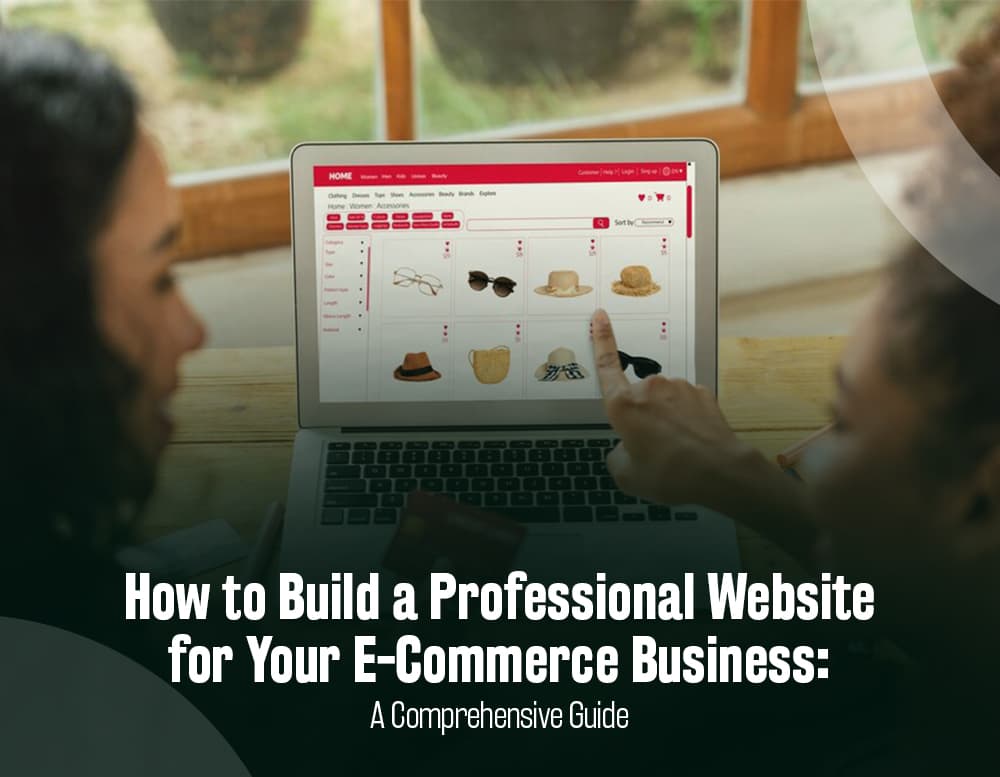How to Build a Professional Website for Your E-Commerce Business: A Comprehensive Guide

Your e-commerce success, in a big way, is directly related to your website. The e-commerce website is going to be your digital storefront, and hence it has to look professional, while assuring visitors of seamless shopping experiences at the same time. Whether you’re launching a new online store or revamping an existing one, this comprehensive guide will walk you through the process of building a professional e-commerce website. From choosing the right eCommerce development company in India to ensuring effective website design, we’ll cover all the key aspects you need to consider.
1. Define Your E-Commerce Goals and Strategy
First things first, understand your business goals and a way to reach them. Ask yourself:
What are you selling?
Who is your target audience?
What is your pricing strategy?
What is your USP?
Once you've answered these, you will have a complete idea of what your website needs to achieve; whether it is a clean and minimalistic design with products in the limelight or a full-fledged e-commerce site to support extensive product categories.
2. Choose the Right E-commerce Development Company
Selecting an experienced eCommerce website design company India is one of the most important decisions you’ll make. Look for a company that has a strong portfolio, positive client testimonials, and expertise in the latest technologies. They should offer a comprehensive range of services, including custom design, mobile optimization, and secure payment integration.
3. Select the Best E-commerce Platform
Next, most crucially important is choosing the right e-commerce platform to suit your needs. The dominant players in the e-commerce software category are:
Shopify: Probably the most user-friendly and scalable, Shopify has a raft of templates and apps that will make the process of creating a professional e-commerce website painless.
WooCommerce: A plugin for WordPress, WooCommerce is ideal for those who want complete control over their website's customization. It is also inexpensive and flexible for users who are well-navigated with WordPress.
BigCommerce: Having the most powerful default features, BigCommerce is best for growing businesses that need advanced e-commerce functionality with minimal reliance on third-party apps.
Magento: As highly customizable open-source software, Magento works for big businesses that need a highly customized solution and have technical resources to keep it updated.
When choosing a platform, a number of aspects have to be considered: ease of use, scalability, customization options, payment-processing gateways, and customer support.
3. Choose a Domain Name and a Hosting Provider
Your domain name is your digital address and is of critical importance when it comes to branding. Your domain name should be:
Memorable: Easy to remember, short, simple, and easy to spell.
Brand-focused: Related to the name of your business or what you sell.
Unique: Not too similar to other competitors, and it is available for registration.
Hosting: E-commerce websites are usually on a sound and secure hosting to make sure that their uptime and speed are quick.
Options include
Shared Hosting: Good for small businesses, but ultimately will be low in speed and performance if your site gets huge traffic.
VPS, or Virtual Private Server Hosting: Much better performance, control, and scaling compared to shared hosting.
Dedicated Hosting: For big businesses, ownership of a server is implied, as maximum control is required.
E-commerce managed hosting: This would include websites like Shopify, in which the hosting is integrated into the site to handle some technical concerns such as security and uptime.
4. Design the Website Layout
The design of your website should focus on enabling clients easily shop while communicating your brand in a professional way. To design such a website aimed at communicating the message to customers, incorporate the following elements:
Home Page: This is going to be your storefront, so make sure to include your main products there. Use high-quality images and add clear CTA buttons like "Shop Now" or "Browse Collection." Navigation: Make sure that your website is user-friendly by arranging intuitive categories and filters for users to find their products. A well-set menu and a search bar will surely enhance the user experience of your online store.
Product Pages: Each product page should have high-resolution images, a detailed description of the product, its price, and its reviews. Wherever possible, enable zooming and 360-degree views for products.
Responsiveness: Over half of total e-commerce traffic arises through mobile devices. Your website design should be fully responsive, meaning it can easily work on every screen size.
Consistent Branding: Make sure that your website has consistent colors, fonts, and a logo throughout all the pages.
You can either hire a professional web designer or use ready-made templates made available by e-commerce platforms. In fact, most of them provide customizable templates that allow you to make adjustments based on your brand.
5. Set Up Payment Gateways and Currencies
Setting up a payment gateway is one of the major steps towards ensuring seamless transactions. The following are some of the popular payment gateways:
PayPal: It is highly trusted by customers and very easy to set up.
Stripe: Very flexible and accommodative to a wide range, right from credit cards to mobile money systems.
Square: Good for those businesses who have a brick-and-mortar store as well, because it easily integrates with point-of-sale systems.
Authorize.net: It does provide much better fraud detection and allows international payments.
Make sure your website supports credit cards, mobile wallets-like Apple Pay, Google Pay-and possibly even cryptocurrencies. With respect to an international audience, you could also set multi-currency options up; just make sure that your payment processor is able to process different currencies.
6. Implement Security Measures
Security, of course, is one of the major concerns of every e-commerce business. Every customer should be made to feel that his or her personal and payment details are safe when making purchases through your website. The following security features should be implemented:
SSL Certificate: Your site should be using an SSL for data encryption in transit between the website and users. This also enhances SEO rankings.
Two-Factor Authentication: This gives an extra security layer for your administrative and user accounts through two-factor authentication.
Common Security Audits: Regularly check the security and auditing to test your website for vulnerabilities to keep it secure.
Data Encryption: Encrypt the sensitive information of your customers, including their sensitive payment details and personal information.
PCI-DSS Compliance: Ensure your e-commerce website aligns with PCI-DSS.
7. Set Up Shipping and Inventory Management
Shipping and inventory are key features for any successful e-commerce business. First, clear shipping policies need to be set up which should define:
Shipping Costs: You have a decision to make on whether to use free shipping, a flat rate, or variable rates depending on location or product weight.
Delivery Time: Provide estimated delivery time and expedite shipping options wherever possible.
Shipping Partners: FedEx, UPS, or DHL should be partnered with for timely delivery.
For inventory management, you must make sure that your setup has the following features:
Tracking of Stock Level: It keeps real-time track of the inventory level to avoid overselling.
Stock Management Across Channels: If one sells on multiple channels, say Amazon or eBay, then an inventory management tool should be set up to keep stock in all channels in sync.
Automates Reordering: You are able to create low-stock notifications to trigger automatic reordering when levels go below threshold.
8. Optimize for SEO and Performance
Search Engine Optimization is a way in which one drives organic traffic to the website. Optimize the site by:
Keyword Research: Use tools like Google Keyword Planner or SEMrush to identify relevant keywords for your products and include them in product descriptions, meta tags, and headings.
Optimized URLs: It means creating SEO-friendly URLs that contain keywords and are readable.
Product Descriptions: Unique, keyword-rich product descriptions that are both informative and persuasive.
Page Speed Optimization: A fast-loading site from image optimization, reduction of plugins used, and using caching.
Mobile Optimization: With the growth of mobile traffic, a website must be optimized for mobile search through responsive design, loading speed, and ease of navigation.
9. Create a Blog for Content Marketing
Adding a blog to your e-commerce website is a better way to connect with your audience and improve your search engine ranking. Focus on:
Product Guides: Creating detailed guides that would enable customers to know how to use your products.
Industry News: You should also be able to share the latest trends and development in your industry.
Customer Stories: You could feature case studies or success stories from your existing customers.
This will continue to build your authority in your niche and can bring organic traffic both from the search engines and social media sites.
10. Integrate Analytics Tools
Understanding customer behavior is vital for optimization. Employ analytics tools to track key metrics, including:
Google Analytics: Track the traffic, bounce rate, and conversion rate.
Heatmaps: Tools such as Hotjar superimpose on the places where people click on your website and let you see which areas of the site draw the most interest.
E-commerce Analytics: Examples include platforms such as Shopify and WooCommerce, having analytics built-in that track sales, average order value, and lifetime value.
Conclusion
Actually, creating a professional e-commerce website has to do with multi-dimensional steps that should be approached with lots of attention to detail in a strategic sense: from defining your business goals to choosing the right platform for e-commerce; from intuitive user interface design to robust security measures implementation, each step is crucial in order for the website to look appealing and work seamlessly.
Picking the right eCommerce development company, platform, designing for user experience, implementing sound payment gateways, and performance and SEO optimization create the core bones of your online store. In addition, effective marketing strategies, integration of analytics tools, and continuous testing and refinement of the website provide the edge to keep it competitive and relevant in ever-changing e-commerce environments.
Recent Blogs

Which Costs More, The Websites or The Mobile App?

Top Five Web Development Companies in India
